Environmental Impact Assessment on Mining Industry: Analysis Report
VerifiedAdded on 2020/02/24
|9
|1446
|41
Report
AI Summary
This report provides a detailed overview of the Environmental Impact Assessment (EIA) process within the mining industry, focusing on its importance and stages. The report begins with an executive summary outlining the aim of the report, which is to provide detailed information about the EIA on the mining industry, particularly in Australia. It then delves into the development of EIA, including screening, identification of study goals, and assessment of environmental issues. The report highlights the harmful consequences of the mining industry and the urgent need for EIA implementation to mitigate pollution and protect natural resources. It outlines various stages of EIA, such as screening, baseline measurements, and impact predictions, and emphasizes the significance of public cooperation and regulatory approvals. The conclusion stresses the responsibility of countries in addressing environmental degradation caused by industrialization and urbanization, advocating for immediate EIA implementation to protect air, water, and natural resources. The report references several studies to support its findings, underscoring the importance of sustainable systems in the mining sector.
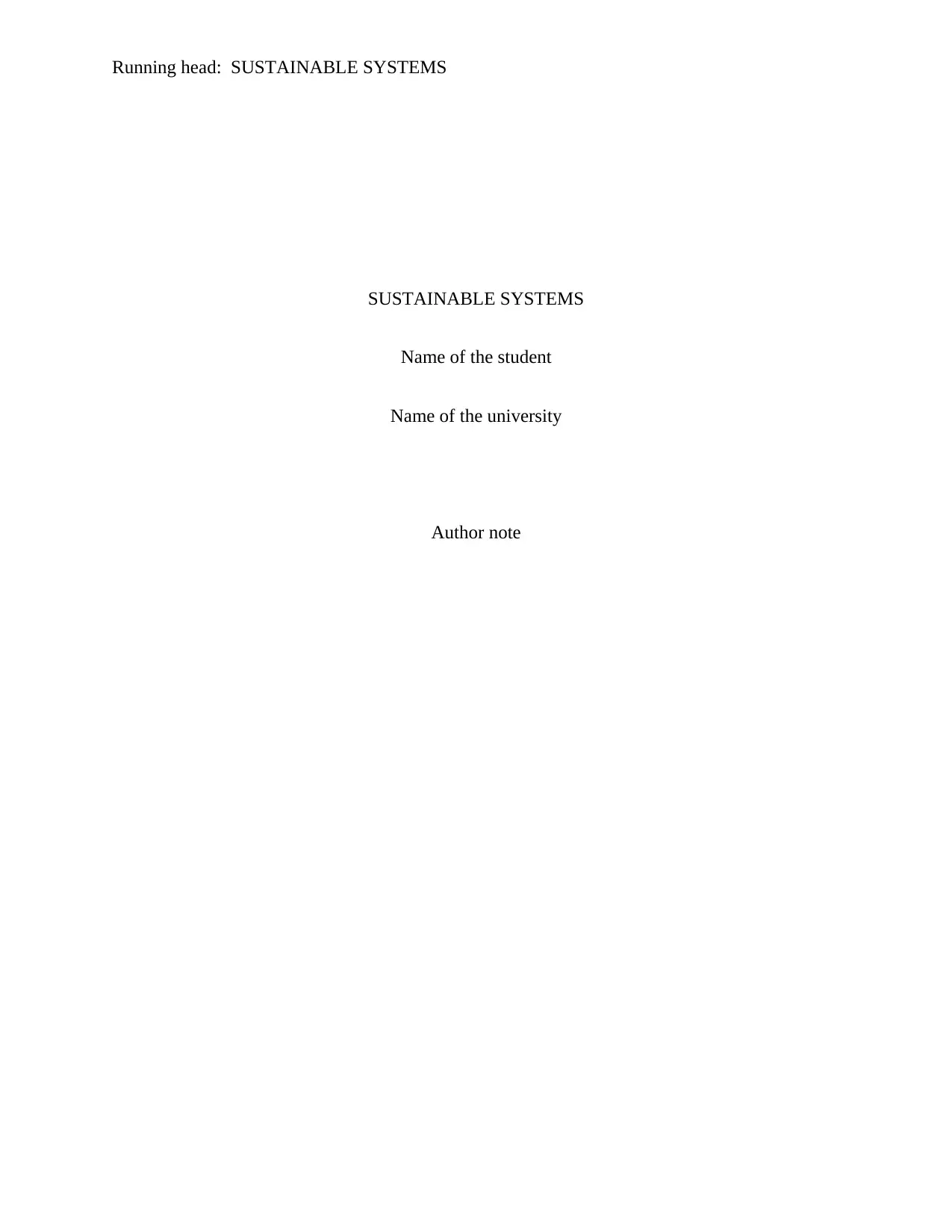
Running head: SUSTAINABLE SYSTEMS
SUSTAINABLE SYSTEMS
Name of the student
Name of the university
Author note
SUSTAINABLE SYSTEMS
Name of the student
Name of the university
Author note
Paraphrase This Document
Need a fresh take? Get an instant paraphrase of this document with our AI Paraphraser
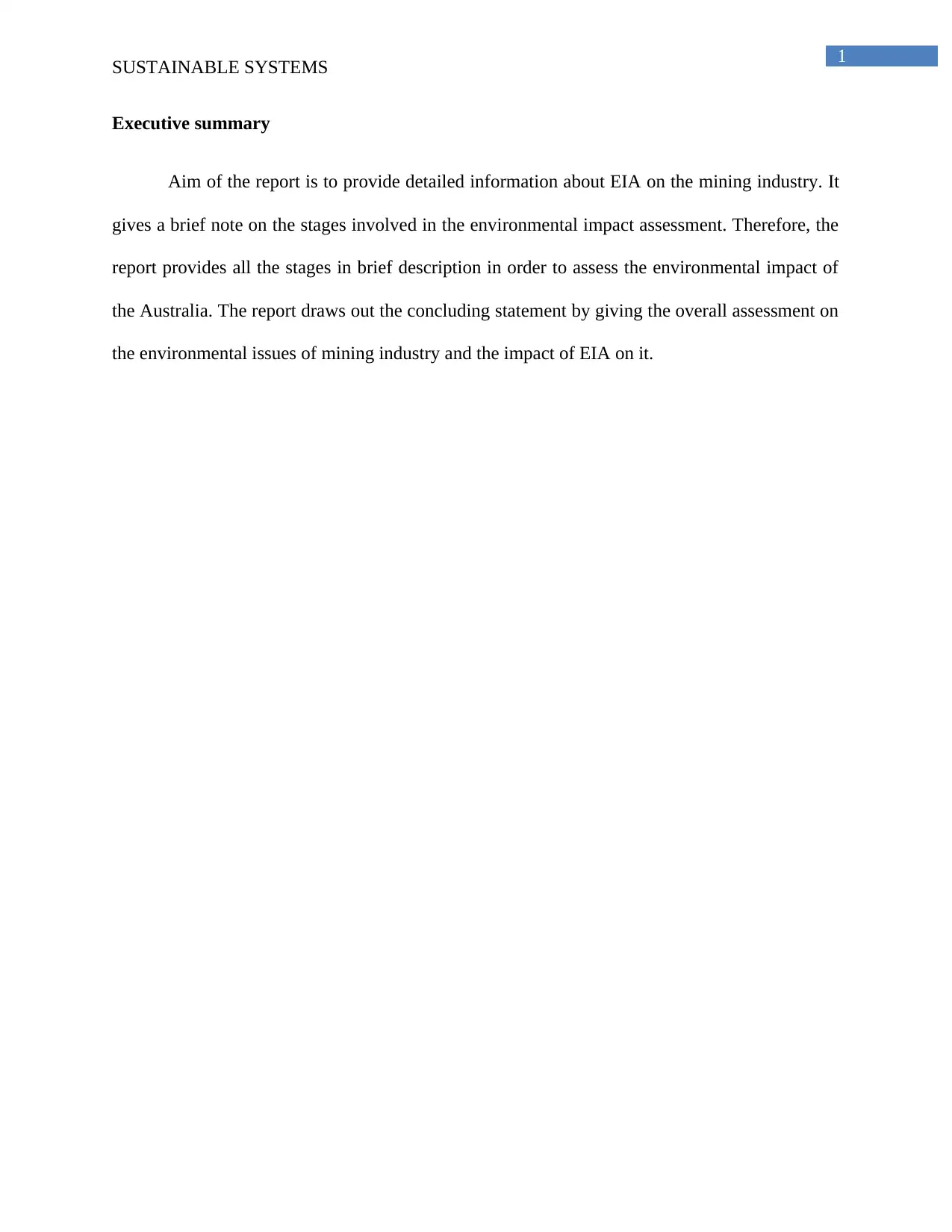
1
SUSTAINABLE SYSTEMS
Executive summary
Aim of the report is to provide detailed information about EIA on the mining industry. It
gives a brief note on the stages involved in the environmental impact assessment. Therefore, the
report provides all the stages in brief description in order to assess the environmental impact of
the Australia. The report draws out the concluding statement by giving the overall assessment on
the environmental issues of mining industry and the impact of EIA on it.
SUSTAINABLE SYSTEMS
Executive summary
Aim of the report is to provide detailed information about EIA on the mining industry. It
gives a brief note on the stages involved in the environmental impact assessment. Therefore, the
report provides all the stages in brief description in order to assess the environmental impact of
the Australia. The report draws out the concluding statement by giving the overall assessment on
the environmental issues of mining industry and the impact of EIA on it.
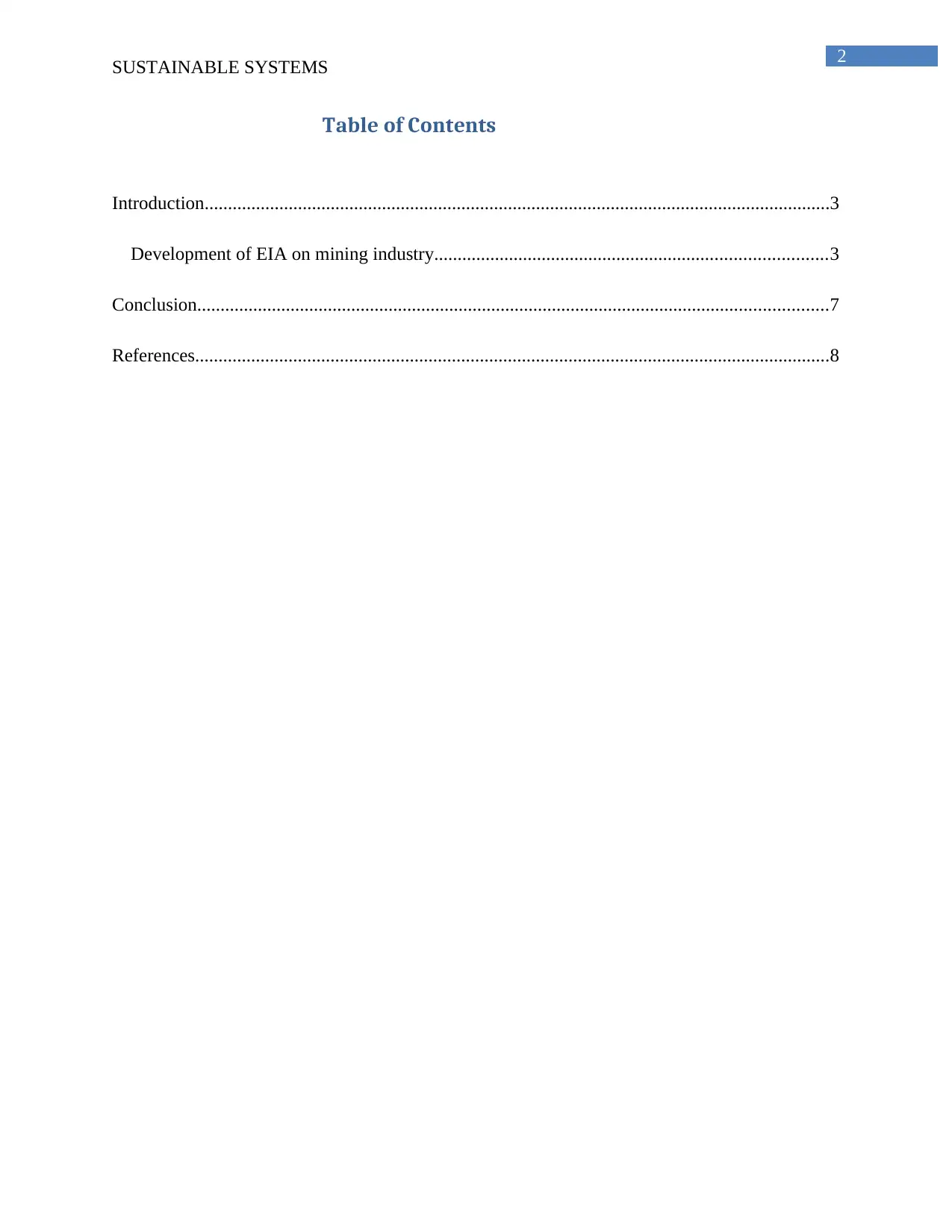
2
SUSTAINABLE SYSTEMS
Table of Contents
Introduction......................................................................................................................................3
Development of EIA on mining industry....................................................................................3
Conclusion.......................................................................................................................................7
References........................................................................................................................................8
SUSTAINABLE SYSTEMS
Table of Contents
Introduction......................................................................................................................................3
Development of EIA on mining industry....................................................................................3
Conclusion.......................................................................................................................................7
References........................................................................................................................................8
⊘ This is a preview!⊘
Do you want full access?
Subscribe today to unlock all pages.

Trusted by 1+ million students worldwide
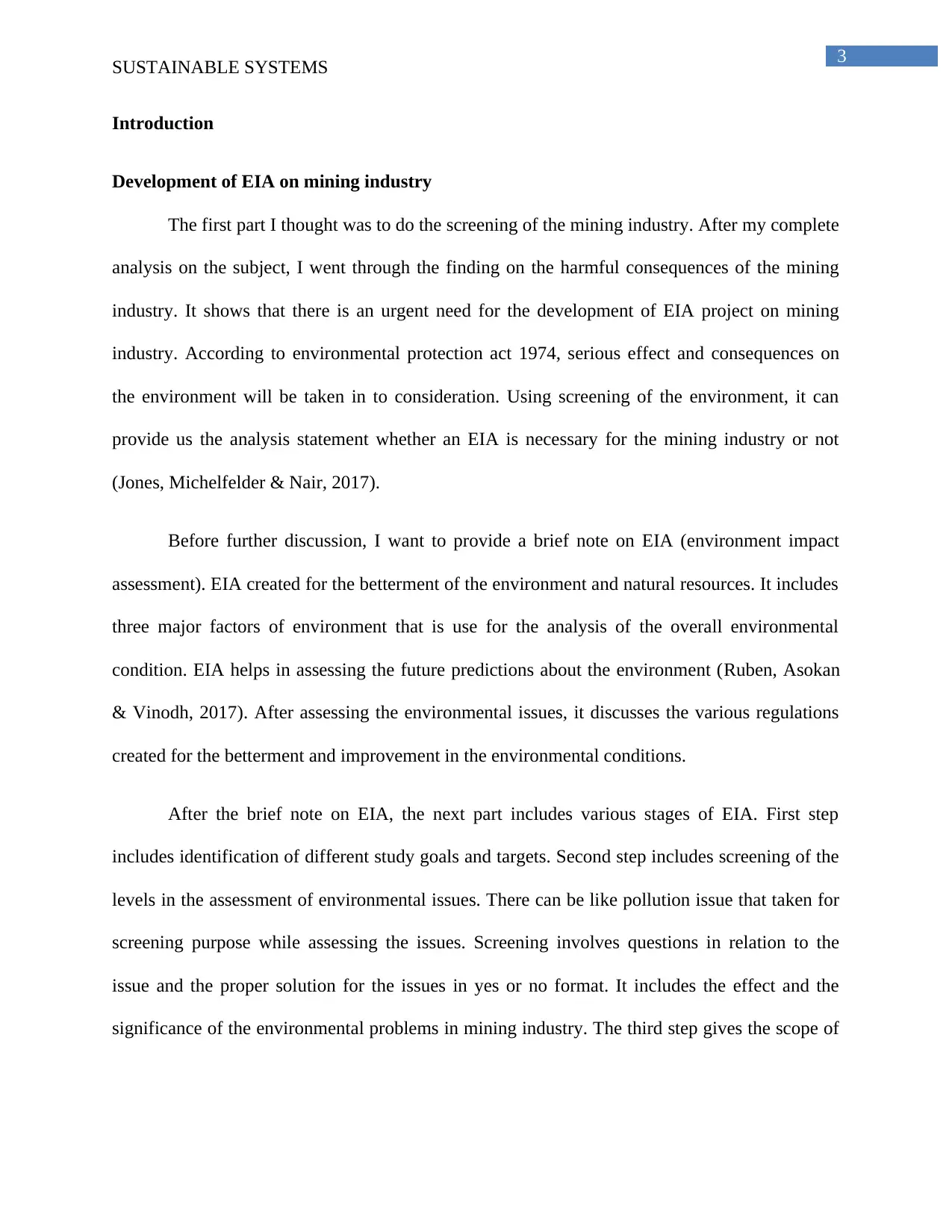
3
SUSTAINABLE SYSTEMS
Introduction
Development of EIA on mining industry
The first part I thought was to do the screening of the mining industry. After my complete
analysis on the subject, I went through the finding on the harmful consequences of the mining
industry. It shows that there is an urgent need for the development of EIA project on mining
industry. According to environmental protection act 1974, serious effect and consequences on
the environment will be taken in to consideration. Using screening of the environment, it can
provide us the analysis statement whether an EIA is necessary for the mining industry or not
(Jones, Michelfelder & Nair, 2017).
Before further discussion, I want to provide a brief note on EIA (environment impact
assessment). EIA created for the betterment of the environment and natural resources. It includes
three major factors of environment that is use for the analysis of the overall environmental
condition. EIA helps in assessing the future predictions about the environment (Ruben, Asokan
& Vinodh, 2017). After assessing the environmental issues, it discusses the various regulations
created for the betterment and improvement in the environmental conditions.
After the brief note on EIA, the next part includes various stages of EIA. First step
includes identification of different study goals and targets. Second step includes screening of the
levels in the assessment of environmental issues. There can be like pollution issue that taken for
screening purpose while assessing the issues. Screening involves questions in relation to the
issue and the proper solution for the issues in yes or no format. It includes the effect and the
significance of the environmental problems in mining industry. The third step gives the scope of
SUSTAINABLE SYSTEMS
Introduction
Development of EIA on mining industry
The first part I thought was to do the screening of the mining industry. After my complete
analysis on the subject, I went through the finding on the harmful consequences of the mining
industry. It shows that there is an urgent need for the development of EIA project on mining
industry. According to environmental protection act 1974, serious effect and consequences on
the environment will be taken in to consideration. Using screening of the environment, it can
provide us the analysis statement whether an EIA is necessary for the mining industry or not
(Jones, Michelfelder & Nair, 2017).
Before further discussion, I want to provide a brief note on EIA (environment impact
assessment). EIA created for the betterment of the environment and natural resources. It includes
three major factors of environment that is use for the analysis of the overall environmental
condition. EIA helps in assessing the future predictions about the environment (Ruben, Asokan
& Vinodh, 2017). After assessing the environmental issues, it discusses the various regulations
created for the betterment and improvement in the environmental conditions.
After the brief note on EIA, the next part includes various stages of EIA. First step
includes identification of different study goals and targets. Second step includes screening of the
levels in the assessment of environmental issues. There can be like pollution issue that taken for
screening purpose while assessing the issues. Screening involves questions in relation to the
issue and the proper solution for the issues in yes or no format. It includes the effect and the
significance of the environmental problems in mining industry. The third step gives the scope of
Paraphrase This Document
Need a fresh take? Get an instant paraphrase of this document with our AI Paraphraser
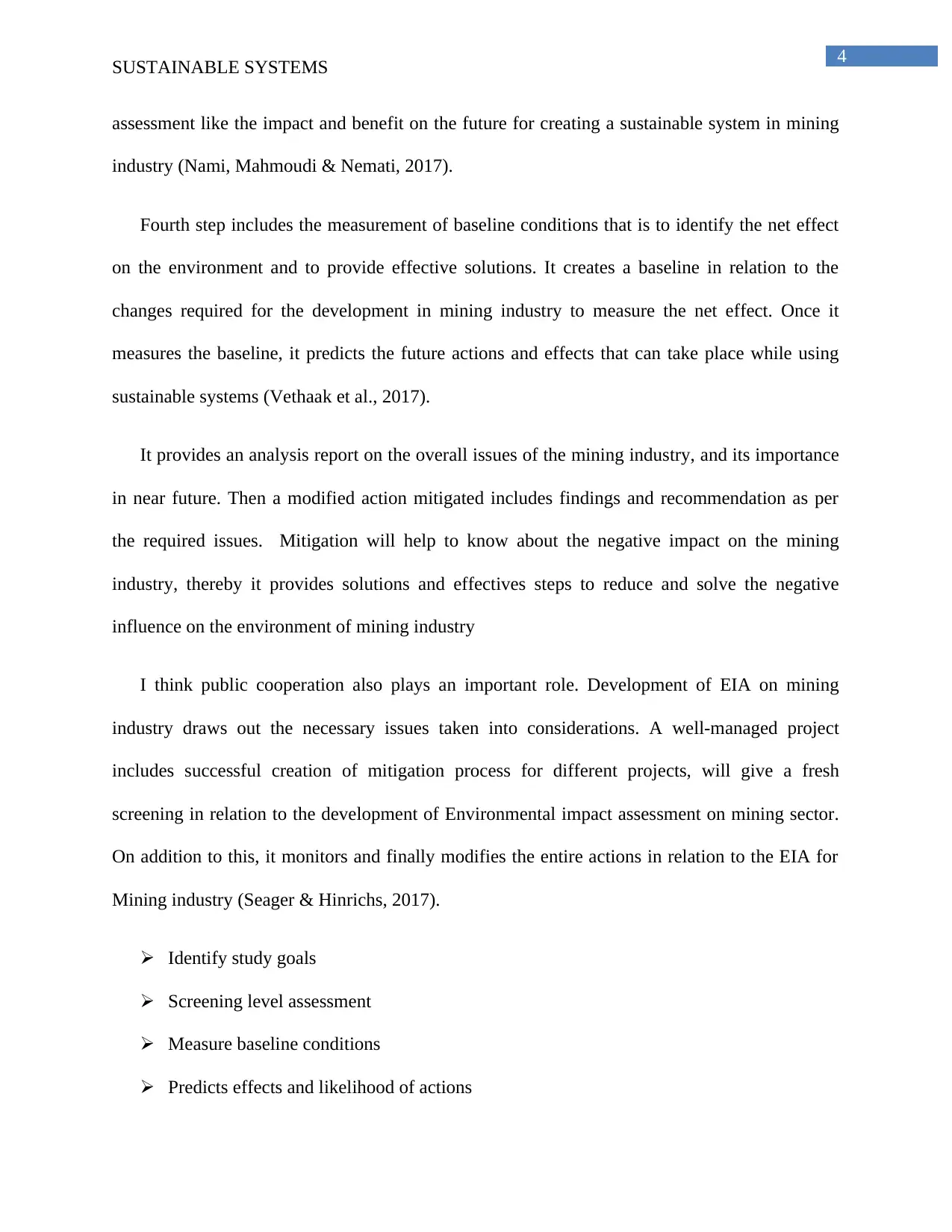
4
SUSTAINABLE SYSTEMS
assessment like the impact and benefit on the future for creating a sustainable system in mining
industry (Nami, Mahmoudi & Nemati, 2017).
Fourth step includes the measurement of baseline conditions that is to identify the net effect
on the environment and to provide effective solutions. It creates a baseline in relation to the
changes required for the development in mining industry to measure the net effect. Once it
measures the baseline, it predicts the future actions and effects that can take place while using
sustainable systems (Vethaak et al., 2017).
It provides an analysis report on the overall issues of the mining industry, and its importance
in near future. Then a modified action mitigated includes findings and recommendation as per
the required issues. Mitigation will help to know about the negative impact on the mining
industry, thereby it provides solutions and effectives steps to reduce and solve the negative
influence on the environment of mining industry
I think public cooperation also plays an important role. Development of EIA on mining
industry draws out the necessary issues taken into considerations. A well-managed project
includes successful creation of mitigation process for different projects, will give a fresh
screening in relation to the development of Environmental impact assessment on mining sector.
On addition to this, it monitors and finally modifies the entire actions in relation to the EIA for
Mining industry (Seager & Hinrichs, 2017).
Identify study goals
Screening level assessment
Measure baseline conditions
Predicts effects and likelihood of actions
SUSTAINABLE SYSTEMS
assessment like the impact and benefit on the future for creating a sustainable system in mining
industry (Nami, Mahmoudi & Nemati, 2017).
Fourth step includes the measurement of baseline conditions that is to identify the net effect
on the environment and to provide effective solutions. It creates a baseline in relation to the
changes required for the development in mining industry to measure the net effect. Once it
measures the baseline, it predicts the future actions and effects that can take place while using
sustainable systems (Vethaak et al., 2017).
It provides an analysis report on the overall issues of the mining industry, and its importance
in near future. Then a modified action mitigated includes findings and recommendation as per
the required issues. Mitigation will help to know about the negative impact on the mining
industry, thereby it provides solutions and effectives steps to reduce and solve the negative
influence on the environment of mining industry
I think public cooperation also plays an important role. Development of EIA on mining
industry draws out the necessary issues taken into considerations. A well-managed project
includes successful creation of mitigation process for different projects, will give a fresh
screening in relation to the development of Environmental impact assessment on mining sector.
On addition to this, it monitors and finally modifies the entire actions in relation to the EIA for
Mining industry (Seager & Hinrichs, 2017).
Identify study goals
Screening level assessment
Measure baseline conditions
Predicts effects and likelihood of actions
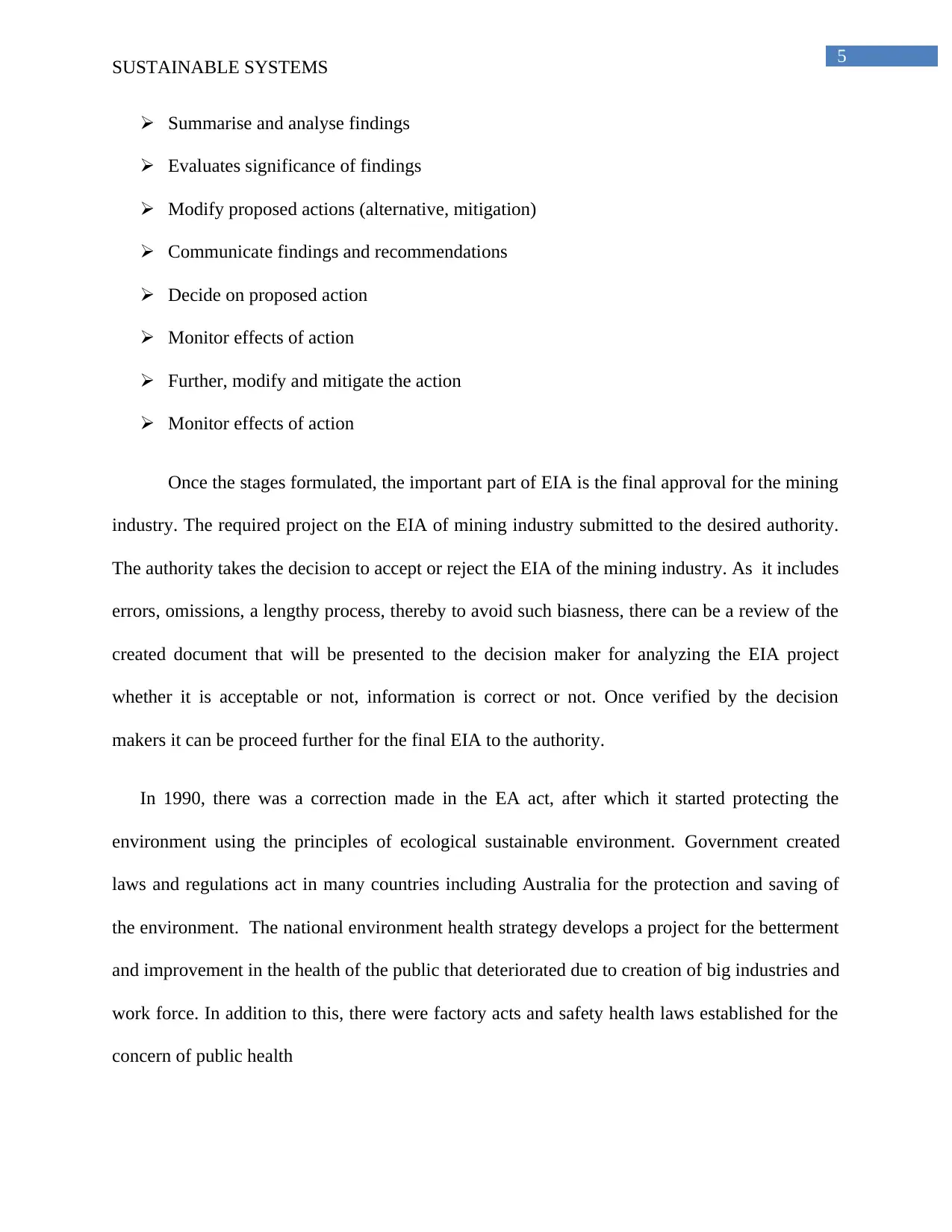
5
SUSTAINABLE SYSTEMS
Summarise and analyse findings
Evaluates significance of findings
Modify proposed actions (alternative, mitigation)
Communicate findings and recommendations
Decide on proposed action
Monitor effects of action
Further, modify and mitigate the action
Monitor effects of action
Once the stages formulated, the important part of EIA is the final approval for the mining
industry. The required project on the EIA of mining industry submitted to the desired authority.
The authority takes the decision to accept or reject the EIA of the mining industry. As it includes
errors, omissions, a lengthy process, thereby to avoid such biasness, there can be a review of the
created document that will be presented to the decision maker for analyzing the EIA project
whether it is acceptable or not, information is correct or not. Once verified by the decision
makers it can be proceed further for the final EIA to the authority.
In 1990, there was a correction made in the EA act, after which it started protecting the
environment using the principles of ecological sustainable environment. Government created
laws and regulations act in many countries including Australia for the protection and saving of
the environment. The national environment health strategy develops a project for the betterment
and improvement in the health of the public that deteriorated due to creation of big industries and
work force. In addition to this, there were factory acts and safety health laws established for the
concern of public health
SUSTAINABLE SYSTEMS
Summarise and analyse findings
Evaluates significance of findings
Modify proposed actions (alternative, mitigation)
Communicate findings and recommendations
Decide on proposed action
Monitor effects of action
Further, modify and mitigate the action
Monitor effects of action
Once the stages formulated, the important part of EIA is the final approval for the mining
industry. The required project on the EIA of mining industry submitted to the desired authority.
The authority takes the decision to accept or reject the EIA of the mining industry. As it includes
errors, omissions, a lengthy process, thereby to avoid such biasness, there can be a review of the
created document that will be presented to the decision maker for analyzing the EIA project
whether it is acceptable or not, information is correct or not. Once verified by the decision
makers it can be proceed further for the final EIA to the authority.
In 1990, there was a correction made in the EA act, after which it started protecting the
environment using the principles of ecological sustainable environment. Government created
laws and regulations act in many countries including Australia for the protection and saving of
the environment. The national environment health strategy develops a project for the betterment
and improvement in the health of the public that deteriorated due to creation of big industries and
work force. In addition to this, there were factory acts and safety health laws established for the
concern of public health
⊘ This is a preview!⊘
Do you want full access?
Subscribe today to unlock all pages.

Trusted by 1+ million students worldwide
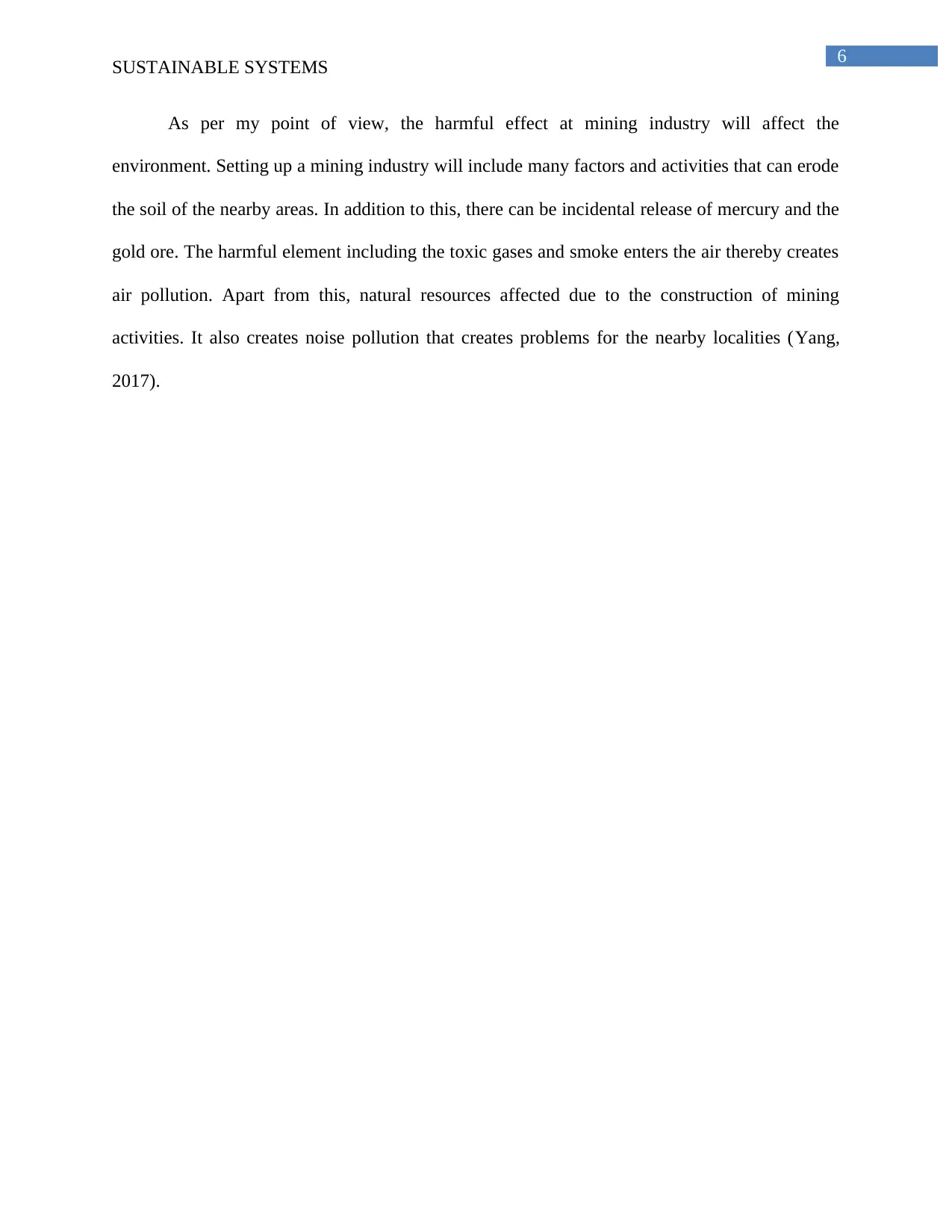
6
SUSTAINABLE SYSTEMS
As per my point of view, the harmful effect at mining industry will affect the
environment. Setting up a mining industry will include many factors and activities that can erode
the soil of the nearby areas. In addition to this, there can be incidental release of mercury and the
gold ore. The harmful element including the toxic gases and smoke enters the air thereby creates
air pollution. Apart from this, natural resources affected due to the construction of mining
activities. It also creates noise pollution that creates problems for the nearby localities (Yang,
2017).
SUSTAINABLE SYSTEMS
As per my point of view, the harmful effect at mining industry will affect the
environment. Setting up a mining industry will include many factors and activities that can erode
the soil of the nearby areas. In addition to this, there can be incidental release of mercury and the
gold ore. The harmful element including the toxic gases and smoke enters the air thereby creates
air pollution. Apart from this, natural resources affected due to the construction of mining
activities. It also creates noise pollution that creates problems for the nearby localities (Yang,
2017).
Paraphrase This Document
Need a fresh take? Get an instant paraphrase of this document with our AI Paraphraser
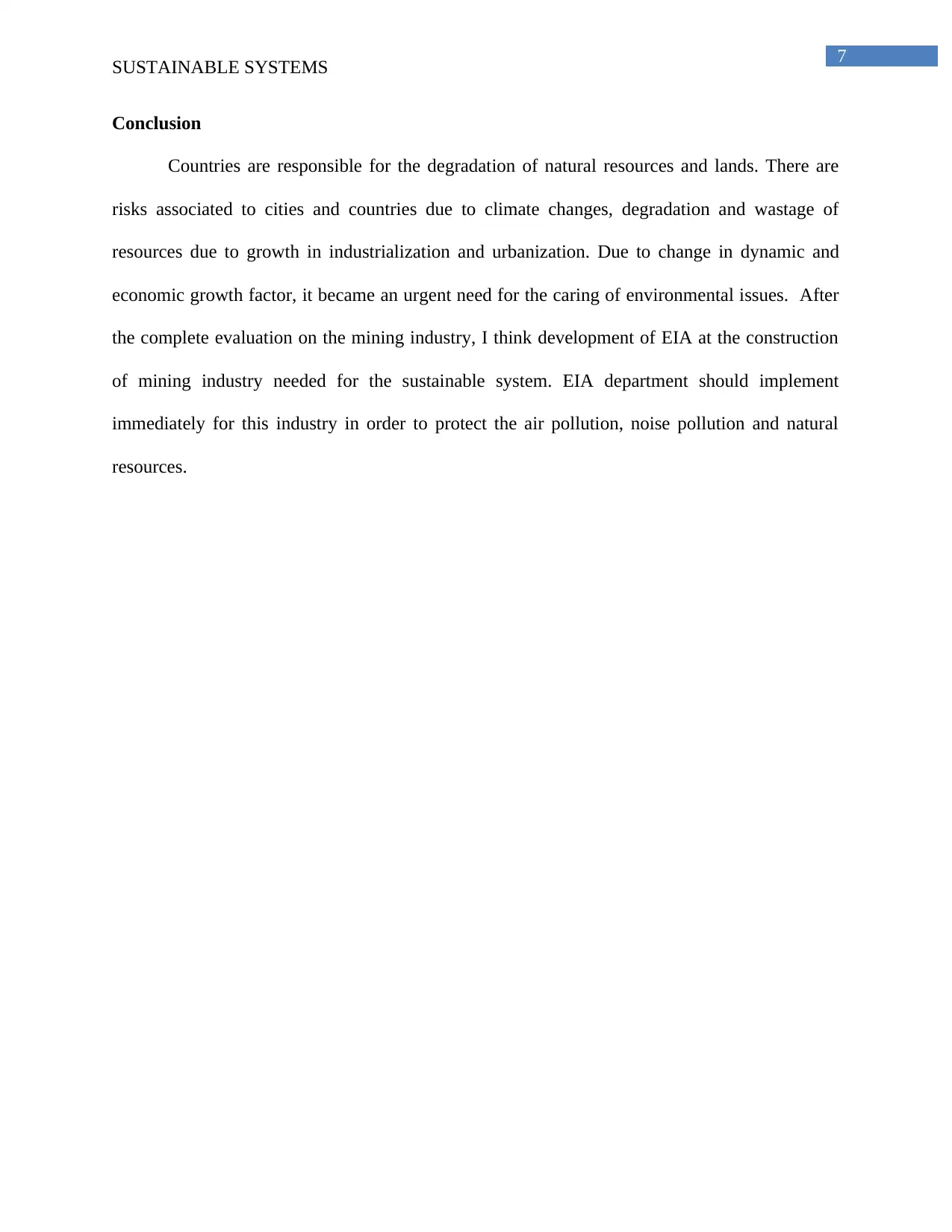
7
SUSTAINABLE SYSTEMS
Conclusion
Countries are responsible for the degradation of natural resources and lands. There are
risks associated to cities and countries due to climate changes, degradation and wastage of
resources due to growth in industrialization and urbanization. Due to change in dynamic and
economic growth factor, it became an urgent need for the caring of environmental issues. After
the complete evaluation on the mining industry, I think development of EIA at the construction
of mining industry needed for the sustainable system. EIA department should implement
immediately for this industry in order to protect the air pollution, noise pollution and natural
resources.
SUSTAINABLE SYSTEMS
Conclusion
Countries are responsible for the degradation of natural resources and lands. There are
risks associated to cities and countries due to climate changes, degradation and wastage of
resources due to growth in industrialization and urbanization. Due to change in dynamic and
economic growth factor, it became an urgent need for the caring of environmental issues. After
the complete evaluation on the mining industry, I think development of EIA at the construction
of mining industry needed for the sustainable system. EIA department should implement
immediately for this industry in order to protect the air pollution, noise pollution and natural
resources.
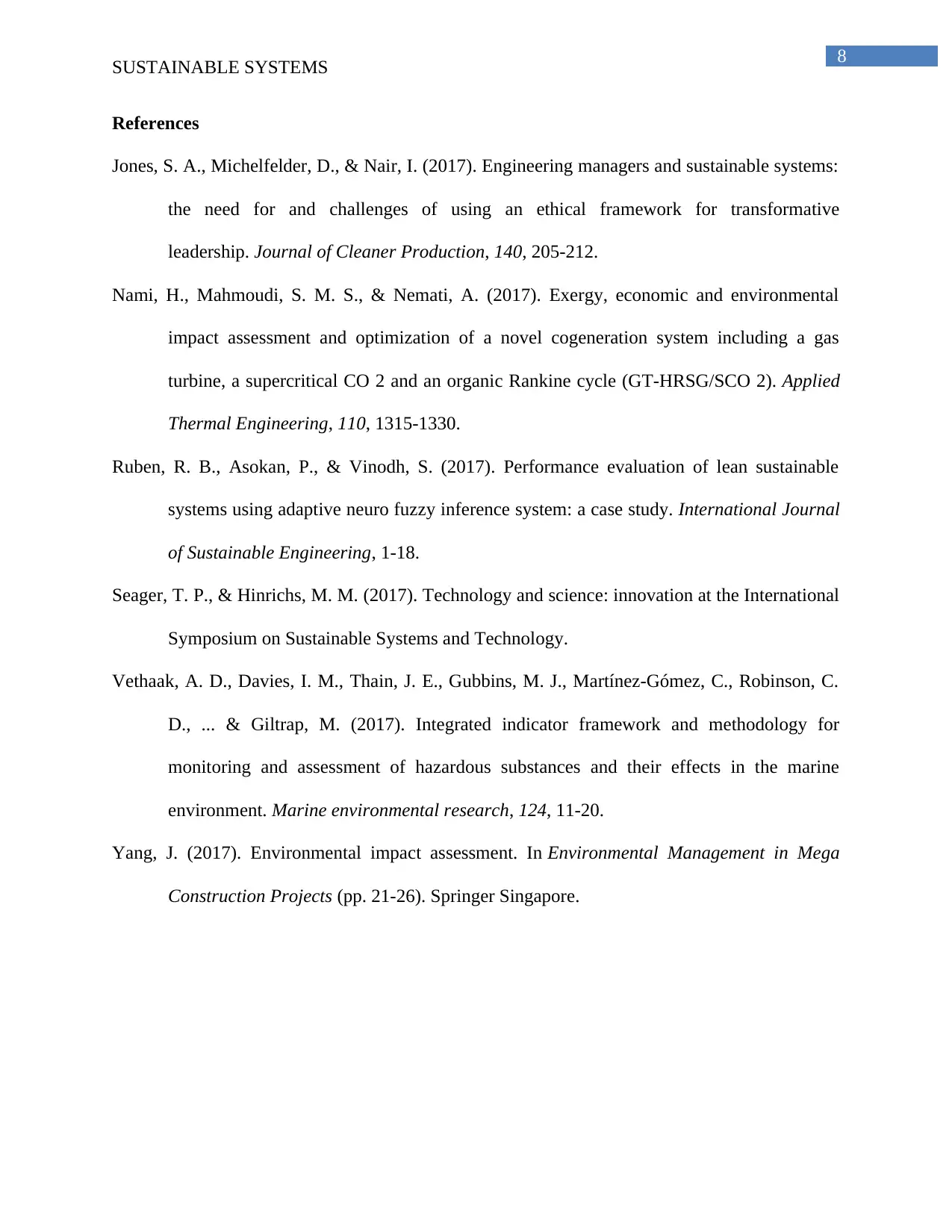
8
SUSTAINABLE SYSTEMS
References
Jones, S. A., Michelfelder, D., & Nair, I. (2017). Engineering managers and sustainable systems:
the need for and challenges of using an ethical framework for transformative
leadership. Journal of Cleaner Production, 140, 205-212.
Nami, H., Mahmoudi, S. M. S., & Nemati, A. (2017). Exergy, economic and environmental
impact assessment and optimization of a novel cogeneration system including a gas
turbine, a supercritical CO 2 and an organic Rankine cycle (GT-HRSG/SCO 2). Applied
Thermal Engineering, 110, 1315-1330.
Ruben, R. B., Asokan, P., & Vinodh, S. (2017). Performance evaluation of lean sustainable
systems using adaptive neuro fuzzy inference system: a case study. International Journal
of Sustainable Engineering, 1-18.
Seager, T. P., & Hinrichs, M. M. (2017). Technology and science: innovation at the International
Symposium on Sustainable Systems and Technology.
Vethaak, A. D., Davies, I. M., Thain, J. E., Gubbins, M. J., Martínez-Gómez, C., Robinson, C.
D., ... & Giltrap, M. (2017). Integrated indicator framework and methodology for
monitoring and assessment of hazardous substances and their effects in the marine
environment. Marine environmental research, 124, 11-20.
Yang, J. (2017). Environmental impact assessment. In Environmental Management in Mega
Construction Projects (pp. 21-26). Springer Singapore.
SUSTAINABLE SYSTEMS
References
Jones, S. A., Michelfelder, D., & Nair, I. (2017). Engineering managers and sustainable systems:
the need for and challenges of using an ethical framework for transformative
leadership. Journal of Cleaner Production, 140, 205-212.
Nami, H., Mahmoudi, S. M. S., & Nemati, A. (2017). Exergy, economic and environmental
impact assessment and optimization of a novel cogeneration system including a gas
turbine, a supercritical CO 2 and an organic Rankine cycle (GT-HRSG/SCO 2). Applied
Thermal Engineering, 110, 1315-1330.
Ruben, R. B., Asokan, P., & Vinodh, S. (2017). Performance evaluation of lean sustainable
systems using adaptive neuro fuzzy inference system: a case study. International Journal
of Sustainable Engineering, 1-18.
Seager, T. P., & Hinrichs, M. M. (2017). Technology and science: innovation at the International
Symposium on Sustainable Systems and Technology.
Vethaak, A. D., Davies, I. M., Thain, J. E., Gubbins, M. J., Martínez-Gómez, C., Robinson, C.
D., ... & Giltrap, M. (2017). Integrated indicator framework and methodology for
monitoring and assessment of hazardous substances and their effects in the marine
environment. Marine environmental research, 124, 11-20.
Yang, J. (2017). Environmental impact assessment. In Environmental Management in Mega
Construction Projects (pp. 21-26). Springer Singapore.
⊘ This is a preview!⊘
Do you want full access?
Subscribe today to unlock all pages.

Trusted by 1+ million students worldwide
1 out of 9
Related Documents
Your All-in-One AI-Powered Toolkit for Academic Success.
+13062052269
info@desklib.com
Available 24*7 on WhatsApp / Email
![[object Object]](/_next/static/media/star-bottom.7253800d.svg)
Unlock your academic potential
Copyright © 2020–2025 A2Z Services. All Rights Reserved. Developed and managed by ZUCOL.




